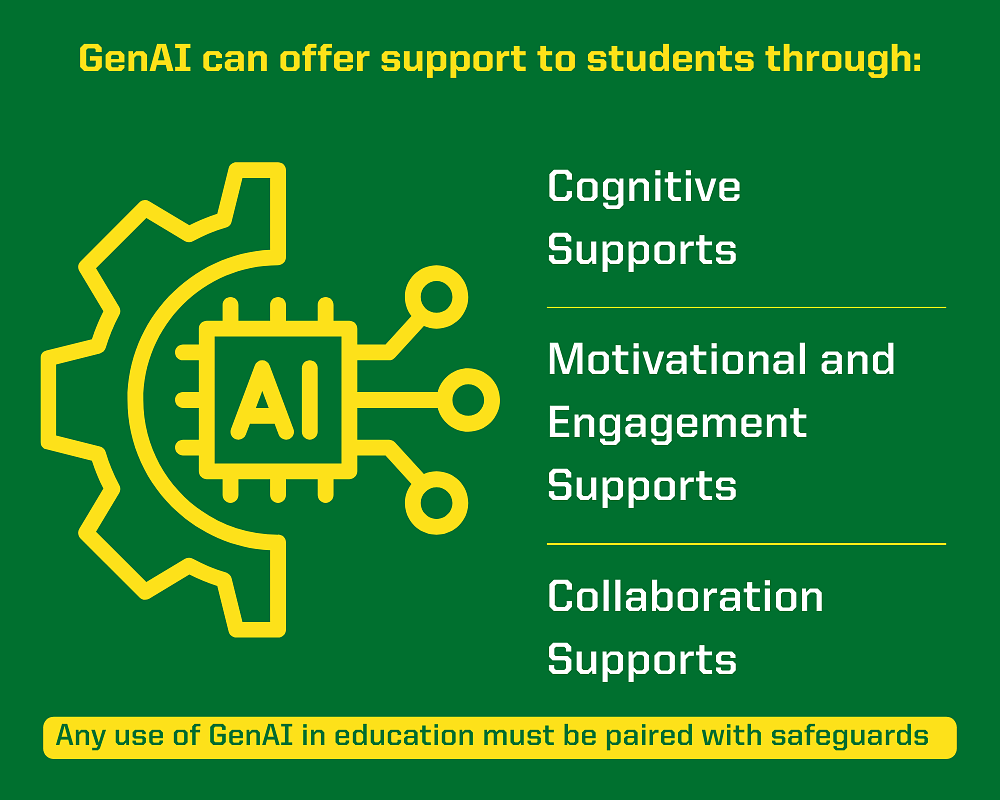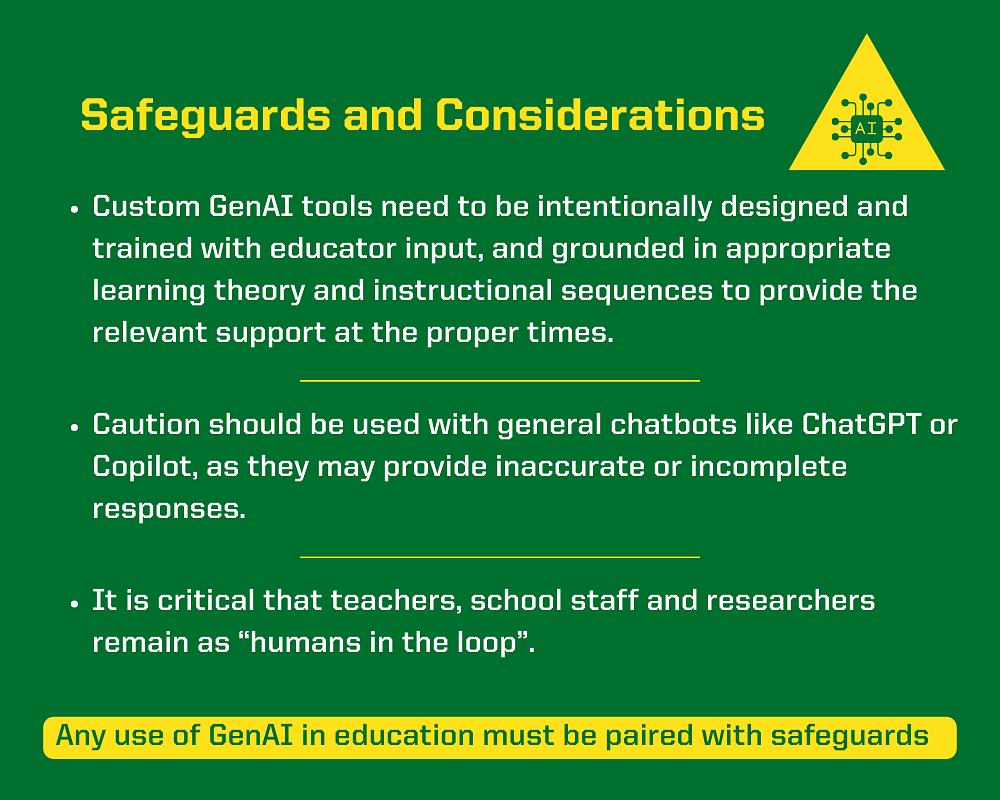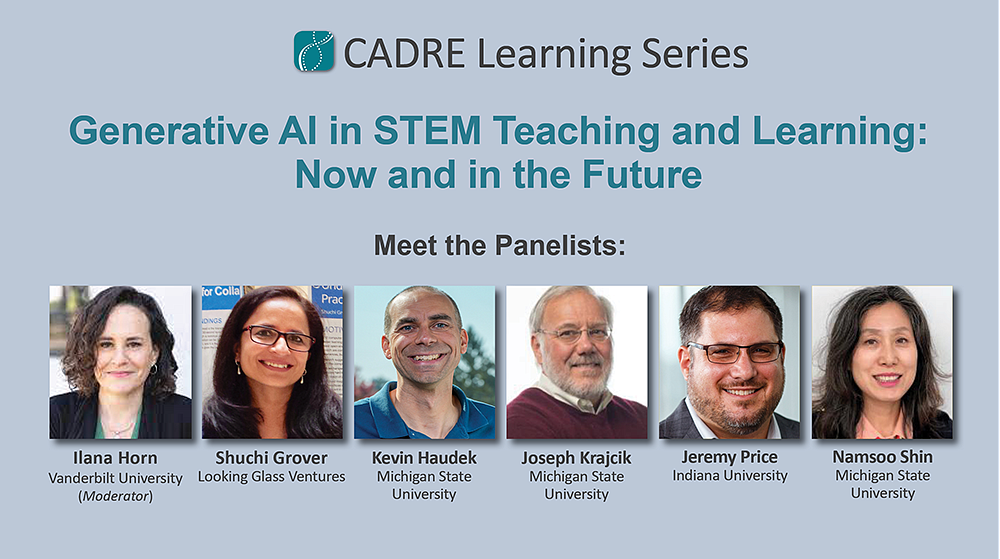By Kevin Haudek, Associate Professor, Namsoo Shin, Associate Professor, and Joseph Krajcik, Director and Professor, CREATE for STEM Institute, Michigan State University.
A learning partner, whether it’s another person or a tool, works with students to boost their thinking, creativity, problem-solving, and motivation. Traditionally, this role has been filled by teachers, peers, and mentors. For years, educators and researchers have explored ways to customize learning activities to meet students’ needs, particularly in STEM education, where students often come in with a wide range of background knowledge and interests. Tools like intelligent tutoring systems focused on personalized learning adapt to individual needs, but they’ve often required extensive programming with limited generalizability.
Now, Generative AI (GenAI) is starting to take on this role by customizing learning experiences to meet student needs and helping students build deeper understanding.1 GenAI-based tools can create and modify content on the fly, evaluate student progress and respond to a variety of student inputs, all in the same system. This makes for more flexible and interactive experiences, with much less setup required. This approach – meeting students' individual needs – is grounded in familiar learning theories, like social constructivism, where students make sense of things through experience, and Vygotsky’s idea of scaffolding,2 where more knowledgeable helpers guide learners until they can work independently. Theories like distributed cognition3 and situated learning4 also show how outside tools can extend student thinking and make learning more meaningful in context. If GenAI tools are going to support students effectively, we need to think carefully about how these evidence-based learning theories can guide their design to ensure they truly support and enhance the work teachers already do.
This blog highlights the promising possibilities of GenAI supporting student learning while only briefly noting the broader challenges. Below, we describe three potential ways GenAI can offer support to students as they learn.

Cognitive supports
GenAI can act as a learning partner by providing cognitive support that helps students build integrated understanding and solve complex or ill-structured problems. This does not mean that off-the-shelf chatbots like ChatGPT or Copilot can fill this role, as they may provide inaccurate or incomplete responses. To truly support learning, custom GenAI tools need to be intentionally designed and trained with educator input and grounded in appropriate learning theory and instructional sequences to provide the relevant support at the proper times. These supports include hints, scaffolds like graphic organizers to help visualize information, sentence stems to guide writing and speaking, and breaking down complex tasks into manageable steps. For example, GenAI can prompt students to consider relevant variables in experimental design or guide evidence evaluation in scientific explanations. It can also deliver customized, actionable, and constructive feedback aligned with learning goals, helping students refine their thinking. Unlike earlier systems, GenAI enables interactive, context-sensitive dialogue and can offer responsive, conversational support throughout the learning process. To ensure that GenAI feedback is accurate and constructive, teachers, staff and researchers must stay involved to review AI-generated comments. Their input will help align suggestions with classroom learning goals and should be used to improve future GenAI performance.
Motivational and engagement supports
GenAI can act as a motivational partner by tailoring science learning experiences to align with students’ interests, values, and cultural contexts—key factors in sustaining engagement. Students are often more motivated when instruction connects to their personal interests, identities or local contexts. For instance, GenAI tools can tailor lessons by asking students a few simple questions about their general interests or a place of interest and then frame science lessons around topics such as information transfer, water pollution, renewable energy, or local ecological issues. This kind of personalization can help sustain engagement by making science learning feel more relevant. GenAI tools can also detect signs of disengagement through behavioral data and respond with supportive prompts or feedback to re-engage students. By offering context-sensitive, personalized support AI can strengthen students’ connection to science and foster motivation for deeper exploration. Humans also need to remain in the loop here to check on the appropriateness of motivational and engagement supports being offered.
Collaboration supports
Collaboration and discourse are critical to developing integrated understanding in STEM. GenAI can act as a learning partner by fostering productive peer interactions. GenAI tools can support group work by analyzing student dialogue, prompting consideration of diverse perspectives, and suggesting ways to extend or clarify ideas. They can also mediate conflicts and encourage equitable participation by helping students build on one another’s contributions. Grounded in distributed cognition theory, this support emphasizes how learning is co-constructed across individuals and tools. GenAI further enhances these functions by serving as a virtual peer or coach, offering real-time, group-level feedback and scaffolding collaborative sense-making in science tasks. Humans also need to monitor collaboration supports.

Safeguards and considerations
Any use of GenAI in education must be paired with safeguards. Students and educators will need ongoing support in developing AI and information literacy to recognize risks such as privacy concerns, biased outputs or hallucinations. As noted above, we find it critical that teachers, school staff and researchers must remain as “humans in the loop”. For example, they should review GenAI suggestions and analyses to ensure accuracy and alignment with learning goals. Teachers’ and researchers’ input and comments should also be used to refine and improve the GenAI tools over time. Beyond classrooms, there are wider ethical concerns, such as the sources of training data and the environmental impacts of developing and running these tools. Addressing both classroom safeguards and broader issues is essential if GenAI is to serve as a partner to complement, rather than a replacement of, human expertise.
The future of GenAI in STEM learning
Looking ahead, an exciting possibility for STEM educators is that GenAI tools could act as learning partners to support students doing real science by engaging in various scientific practices - asking questions, analyzing data, building models, and writing evidence-based explanations. Imagine an GenAI tool that prompts a student to revisit their reasoning when constructing scientific explanations and adapts over time to gradually foster independence. For teachers, this means having a partner that can reinforce key science practices and ideas while they focus on guiding rich discussions, monitoring student thinking, and connecting learning to real-world contexts.GenAI can help make STEM learning more linked to students’ backgrounds and personal interests. For example, it can customize science tasks around student interests, such as linking chemical reactions to local environmental issues. GenAI can also boost accessibility by translating materials or visualizing concepts for students with reading difficulties. Some tools even analyze group discussions or body language to encourage quieter students to participate. As these tools evolve, they could help teachers manage classroom complexity, provide feedback on student models or explanations, and support participation for all students — ensuring that every student has opportunity to do meaningful science and develop a strong STEM identity. In turn, this support enables teachers and students to have more high-quality interactions in their classrooms, promoting meaningful learning and deeper understanding. However, significant work remains to ensure this promise is realized effectively. By conducting rigorous research on best practices with GenAI, leveraging human resources, and preventing biases, we can ensure the potential of GenAI in education continues to shine, illuminating a path to a more effective educational system for all. This blog is a small piece of a larger conversation on an emerging and complex topic. The full three-part CADRE series also explores ethics, teacher preparation, and other key considerations that provide a richer context for these and other ideas related to GenAI.

References
1. Shin, N., Haudek, K., & Krajcik, J. (2025). The Potential of Using AI to Improve Student Learning in STEM: Now and in the Future. Community for Advancing Discovery Research in Education (CADRE). Education Development Center, Inc.
2. Vygotsky, L. S. (1978). Mind in Society: The Development of Higher Psychological Processes. Cambridge, MA: Harvard University Press.
3. Pea, R. D. (1993). Practices of distributed intelligence and designs for education. In G. Salomon (Ed.), Distributed cognitions (pp. 47-87). New York; Cambridge University Press. i
4. Brown, J. S., Collins, A., & Duguid, P. (1989). Situated cognition and the culture of learning. Educational Researcher, 18(1), 32-42.
HEDCO Institute article 24 - Sept 17, 2025

